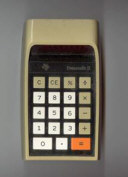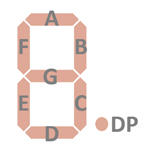
DATAMATH CALCULATOR MUSEUM
 |
DATAMATH CALCULATOR MUSEUM |
Texas Instruments introduced in June 1976 with the two scientific calculators SR-40/TI-30 and the financial calculator Business Analyst its Majestic product line. The first calculators made use of the TMC0980 single-chip calculator circuit, an extension of the TMS1000 Microcomputer Product Family and optimized for calculators with up to 40 keys and a 9-digit LED Display powered by a 9V battery. The TMC0980 chip includes 18,432 Bits Read-Only Memory (ROM, 2k*9 Bits) and 576 Bits Random-Access Memory (RAM, 9 Registers * 16 digits), a 4-bit Arithmetic unit, a programmable PLA for segment decoding and both segment and digit drivers for a 9-digit LED Display.
Later calculators in the Majestic line like the TI-55, TI Programmable 57, and The MBA used with the TMC1500 family a much more capable calculator brain more than doubling the SAM capacity and supporting 12-digit displays. In contrast to the Digit Processor architecture used with the TMC0980, continues the TMC1500 the Register Processor approach known from the TMC0500 family introduced already in January 1974 with the SR-50. With 26,624 Bits Read-Only Memory (ROM, 2k*13 Bits) and 1,280 Bits Serial-Access Memory (SAM, 20 Registers * 16 Digits) the TMC1500 was TIs most complex Register Processor and combined about 30,000 transistors on a silicon die about the size of the original TMS1802 single-chip calculator circuit with its 5,000 transistors.
Due to a flexible design concept with both programmable ROM and segment decoder some design variations appeared.
Texas Instruments developed for the TMC1500 a unique multiplexing approach for the 12-digit LED Display to reduce the number of output ports: One output shares Digit Driver 1 (rightmost) and DP (Decimal Point) and one output shares Segment D and Digit Driver 12, consequently calculators designed with the TMC1500 can't display a decimal point on the right most digit or activate the lower segment on the leftmost digit.
QUICK-LINK to Calculator Circuits with LED Direct-Drive.
| Type | Calculator/Product | Application | Comments |
| TMC1501 | TI Programmable 57, Híradástechnika PTK-1050, Radio Shack EC-4000 | Programmable Scientific |
12 (8+2) digits |
| TMC1502 | The MBA, TI-42 MBA | Financial | 12 (8+2) digits |
| TMC1503 | TI-51 III, TI-55 | Scientific | 12 (8+2) digits |
| Description | Comments | |
| Architecture | Single-chip Calculator | Scientific, Financial, Programmable |
| Category | Register Processor | BCD-serial |
| Related | ||
| ROM Size | 26,624 Bits | 2048 Words * 13 Bits |
| SAM Size | 1,280 Bits | 20 Registers * 16 Digits (SAM) |
| Outputs | 12 Digits, 8 Segments | Internal Digit and Segment Drivers |
| Inputs | 5 Keyboard, 1 Frequency Adjust |
Segment to Keyboard Scan-Matrix |
| Item | Min | Typ | Max | Unit | Comments |
| VSS | 0 | V | (Black wire on TI calculators!) | ||
| VDD | -9.0 | V | (Red wire on TI calculators!) | ||
| VBIAS | 2.0 | V | (Internal charge pump) | ||
| CK | 650 | kHz | Internal oscillator,
adjusted with a resistor from FADJ to VDD |
The TMC1500 was manufactured in a 6 um metal gate PMOS process (metal width = 0.25 mil / 6.0 um, metal spacing = 0.25 mil / 6.0 um, diffusion width = 0.15 mil / 4.0 um, diffusion spacing = 0.30 mil / 8.0 um).
The die size of the TMC1500 is approximately 240 mils * 235 mils / 6.1 mm * 6.0 mm.
The TMC1500 uses a 0.6” wide 28-pin DIP (Dual In-line Package with a 0.1” / 2.54 mm lead pitch).
| Pin | IO | Function | Pin | IO | Function |
| 1 | V | Positive Voltage VSS | 28 | O | Segment driver G |
| 2 | O | Digit driver 1
(rightmost), Segment driver DP |
27 | O | Segment driver F |
| 3 | O | Digit driver 2 | 26 | O | Segment driver E |
| 4 | O | Digit driver 3 | 25 | O | Segment driver C |
| 5 | O | Digit driver 4 | 24 | O | Segment driver B |
| 6 | O | Digit driver 5 | 23 | O | Segment driver A |
| 7 | O | Digit driver 6 | 22 | O | Segment driver D, Digit driver 12 (leftmost) |
| 8 | O | Digit driver 7 | 21 | n.c. | |
| 9 | O | Digit driver 8 | 20 | I | Keymatrix input 5 |
| 10 | V | Negative Voltage VDD | 19 | I | Keymatrix input 4 |
| 11 | O | Digit driver 9 | 18 | I | Keymatrix input 3 |
| 12 | O | Digit driver 10 | 17 | I | Keymatrix input 2 |
| 13 | O | Digit driver 11 | 16 | I | Keymatrix input 1 |
| 14 | V | Charge pump Voltage VBIAS (10 nF to VSS) |
15 | A | Frequency Adjust (100 -330 kΩ to VDD) |
| The Segment drivers A-G and DP (Decimal Point) are connected to the display in the pictured way. |  |
The keyboards of all calculators based on the TMC1500 Product Family consist of an x/y-matrix connected to eight segment outputs and the keymatrix inputs K1, K2, K3, K4, and K5.
Example for the TI-55 with TMC1501:
| K1 | K2 | K3 | K4 | K5 | |
| Seg. E | 2nd | sin | cos | tan | CLR |
| Seg. F | INV | % | lnX | eX | x√y |
| Seg. B | x<>y | x2 | √x | 1/x | yX |
| Seg. G | ∑+ | EE | ( | ) | ÷ |
| Seg. C | STO | 7 | 8 | 0 | × |
| Seg. A | RCL | 4 | 5 | 6 | − |
| Seg. D | SUM | 1 | 2 | 3 | + |
| Seg. DP | CE | 0 | . | +/− | = |
Calculators based on the TMC1500 make use of 12-digit LED Displays with common cathode architecture.
If you have additions to the above datasheet please email: joerg@datamath.org.
© Sean Riddle and Joerg Woerner, January 12, 2021. No reprints
without written permission.